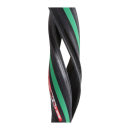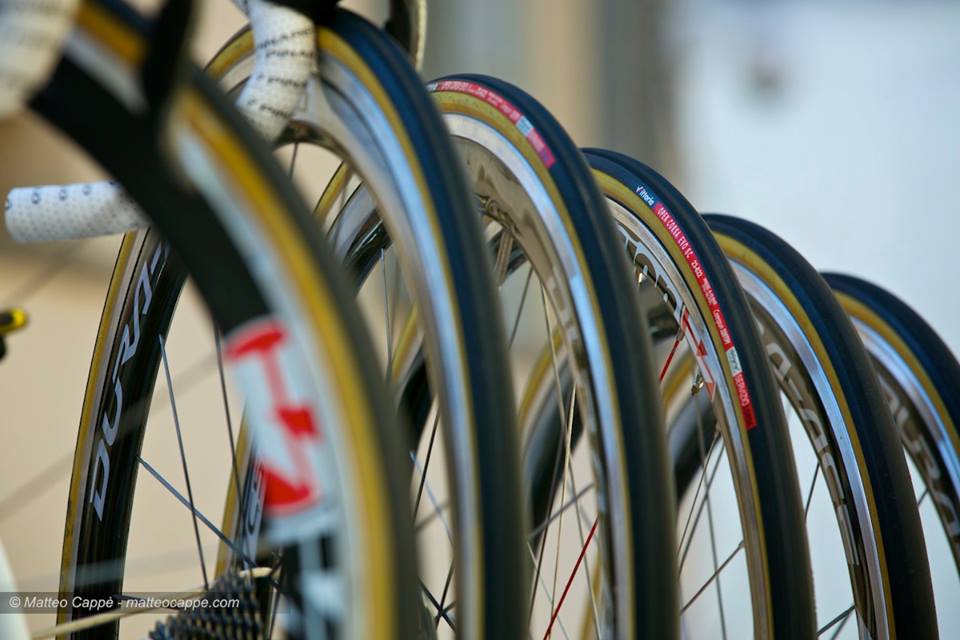With oversized bottom brackets being the norm and steerer tubes tending towards 1 1/2″ at the bottom it would seem that bigger is definitely better, but one case where this has always been the opposite, is with tyres. No self-respecting roadie would be seen turning up to a race on anything other than a 700 x 23mm tyre, or are they simply ignoring the choice of 24 and 25mm tyres because of the ‘stigma’ and mental benefits of riding the 23mm standard road tyre?
With Mr Flecha riding 28 mm tubs at 75 psi at the Paris-Roubaix and many others following, just what is up with wider tyres?
In my 5 odd years of road cycling I’ve been a fan and have to admit to liking a 25mm tyre for everything but that important race – again probably due to the constant mental reminder that racing on anything other than a 23mm just isn’t cricket, on a side note – come on England! (an Ashes reference for those who aren’t reading this in the UK or Australia).
So what do 25mm’s lose out on compared with their slimmer 23mm counterparts – of which there are many more tyres available in both 23 and 25mm than you may have previously thought???
Contrary to most people’s thoughts, a 25mm tyre isn’t really any slower than a 23mm. The aero advantage by slimming down to a 23mm will be so small it’ll be unnoticed.
A 25mm profile is actually ’rounder’ than a 23mm – picture if you can the rim which remains a constant width regardless of tyre and then how a 23mm and 25mm profile looks – the 25mm is round. Wider, but rounder which doesn’t affect how the tyre rolls and gives you a comfier ride and more progressive ‘lean’ when throwing the bike around.
Where they do suffer is with weight, more material is always going to weigh more. I’ve compared on my desk with some accurate scales and a 23mm Gatorskin weighs 22g less than a 25mm.
For training and longer rides the more comfortable and more supple 25mm takes away some of the sharp shocks and leaves you fresher at the end of a ride. They can also often be run at lower pressures which helps this even more.
What 25mm tyres choice have you got?
Michelin, Continental and Vittoria all produce tyres which can be found in 23mm and 25mm states.
Let’s start with Michelin and their relatively new Pro Optimum tyres.
Aimed at longer distance riders and those who long for a comfy ride:
-
Michelin Pro Optimum Tyre
Buy now with free deliverySpecially developed front and rear tyres cater specifically for the task at hand.
With the front tyre carrying just 30% of the total weight but having to cope with nearly all of your braking, its compound is suited to being grippy and reassuring in all conditions.
The rear carries the majority of the weight and is made from a tougher compound ready to plough on for mile after mile on long rides.
They’re both 25mm wide and have anti-puncture belts in them – no tyre is puncture proof however!
Running between 85 and 110 psi they should be OK for most riders.
-
Continental GP4000 - 25mm
You’ll all have heard of the GP4000 more often found in ‘s’ form, Continental do produce a 25mm version of this popular tyre.
A fast tyre (claimed to weight 215g) and perfect for those who want to race – it certainly won’t feel slow! Complete with a Vectran belt for preventing punctures and with 20% less rolling resistance than its predecessor.
-
Continental Gatorskin and Gator Hardshells
Found on the majority of the staff winter bikes is one of these tyres.
A well known and very popular tyre which can cope with dreadful conditions while rolling very well.
The Hardshell version adds a third Polyamide layer in the sidewall to make a unique 3-ply casing for the Gator Hardshell. They’ve also added a wider Poly-X anti puncture breaker belt under the tread which extends down into the shoulder area for wider coverage. Add this to the Duraskin anti-tear mesh on the outside of the casing and nothing is going to stop you on that gruelling training ride!
Heavier than the others, this tyre is more suited to winter training and commuters who need to deal with city streets.
-

Buy now with Probikekit The Vittoria Pave Evo CG - Clincher and Tubular
Buy now with free deliveryAdorning most of the Pro’s bikes on their winter training rides and in tough races where the weather and surfaces are variable and often full of gravel, cobbles and kerbs.
You can see the distinctive green bands a mile off and the Pave performs as well as it looks. Although these are technically a 24mm tyre they still do the job of improving ride and being able to cope with all conditions. If the Pros are willing to race on them they must be good.
The clincher will be relevant to most people, if you can afford to train on tubs then bravo but the disadvantages surely outweigh the benefits? It weighs in at a claimed 240g which is on the high side, this is made up for by the toughness and grip which the Vittoria compound allows.
The tubular weighs just 30g more and is what I’d be riding if I rode tubulars and raced in all conditions.
Given that they pass the Paris-Roubaix test with flying colours, I don’t think there’s much else to challenge these as the best tyre for racing on and being able to deal with rain and poor surfaces.
So it would seem that 25mm tyres aren’t just for Christmas, they are ideal for the all-year-round cyclist. Let us know your thoughts in the comments – do you race on anything other than 23mm’s?

